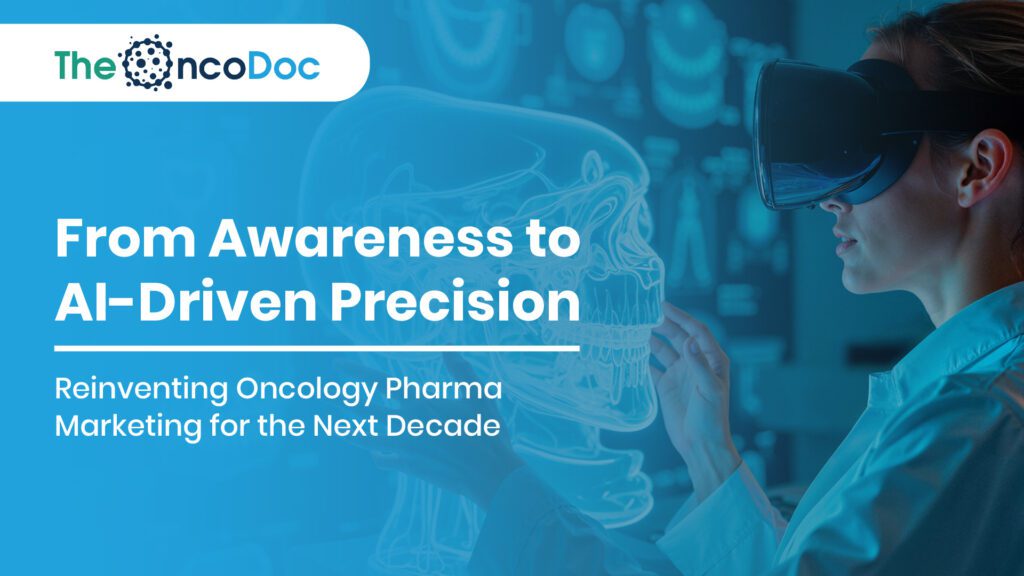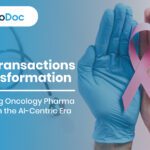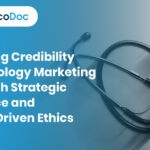Introduction: AI, Oncology, and the New Era of Pharma Marketing
The oncology landscape is undergoing a transformation unlike any before. With cancer cases projected to rise by 47% globally by 2040, and treatment modalities becoming more complex, the expectations from pharmaceutical companies are evolving. No longer is it enough for pharma marketing to focus on broad awareness campaigns or product-driven promotions. The market now demands precision, personalization, and clinical utility, and artificial intelligence (AI) is the catalyst enabling this shift.
For oncologists, the daily challenge is managing diverse patient profiles, navigating complex treatment guidelines, and ensuring timely, cost-effective interventions. In this high-stakes environment, marketing that simply informs is insufficient, it must enable decision-making, integrate into clinical workflows, and ultimately improve patient outcomes.
AI-powered analytics, decision support tools, and real-world data platforms are enabling pharma marketers to go beyond visibility and into value creation. By embedding AI into their engagement strategies, companies can transform oncology marketing from being transactional to transformational.
1. Rethinking Digital Pharma Marketing: From Promotion to Precision
Historically, oncology marketing emphasized reach-based metrics, click-through rates, impressions, and ad recall. While these still have a place, they fail to address the core question for oncologists: “Does this help me treat my patients better?”
A 2025 survey by the Global Oncology Marketing Forum (GOMF) revealed that oncologists’ top preferences in pharma digital engagement are:
- 37%: AI-powered treatment decision tools
- 25%: Localized real-world evidence (RWE) insights
- 18%: AI-driven patient education resources
- 12%: Peer-to-peer expert discussions
- 8%: Brand-centric promotions
This reinforces the principle that clinical utility outperforms promotional volume. Pharma brands must focus on delivering actionable, context-specific resources rather than generic promotional messages.
2. AI as a Differentiator in Oncology Marketing
AI is not just a back-end analytics tool, it is now a frontline differentiator in oncology engagement. From decision support to patient risk prediction, AI-powered platforms are shaping treatment pathways and, in turn, pharma marketing approaches.
Key AI-Enabled Tools Transforming Engagement
- Predictive Eligibility Models – Identify patients suitable for immunotherapy, targeted therapy, or combination regimens based on biomarker profiles and staging.
- Real-Time Toxicity Alerts – Monitor EHR data to flag potential immune-related or cumulative toxicities.
- Adaptive Treatment Algorithms – Adjust protocols dynamically as new data emerges from both clinical trials and real-world evidence.
- AI-Powered Case Matching – Suggest similar anonymized cases to oncologists for complex treatment decisions.
Case Example:
A pan-Asian breast cancer brand introduced an AI-based “Treatment Pathway Optimizer” integrated into hospital oncology EMRs. In 6 months:
- Over 2,200 oncologists actively used it.
- 42% reported improved treatment confidence.
- Time to therapy initiation was reduced by 18%.
This type of AI-driven engagement transforms a brand from being a supplier to being a partner in care.
3. Leveraging Real-World Evidence (RWE) for Market Credibility
RCTs remain the gold standard for regulatory approval, but real-world data (RWD) is emerging as a critical trust-building element in oncology marketing. Physicians increasingly want to know: How does this therapy perform in my patient population?
Strategies for Effective RWE Integration
- Region-Specific Data: Showcase treatment responses in comparable demographic and genomic profiles.
- Outcome Visualizations: Use dashboards to present survival curves, response rates, and toxicity profiles.
- Local Case Registries: Collaborate with hospitals to generate retrospective data analysis.
- Multi-Center Studies: Highlight treatment efficacy across various care settings, from metros to Tier 2/3 cities.
Example:
An Indian colorectal cancer brand used RWD from 11 cancer centers to demonstrate therapy tolerability in patients with high comorbidity rates. As a result, therapy adoption in non-metro centers increased by 27% within a year.
4. Optimizing Content Delivery for the Time-Starved Oncologist
In oncology practice, time is the most valuable commodity. Studies show oncologists spend an average of 2–3 minutes on any digital resource. The success of marketing therefore depends on content efficiency.
Preferred Digital Content Formats by Oncologists (Asia-Pacific, 2025)
- Short AI-generated videos (<90 sec): 34%
- Visual treatment flowcharts: 30%
- AI-interactive PDFs: 20%
- Case-based podcasts: 10%
- Full-length webinars: 6%
Insight: Content should be mobile-first, concise, and interactive, integrated with AI to customize delivery based on the oncologist’s past engagement patterns.
5. Multi-Stakeholder, Multi-Language Digital Outreach
In oncology, patient outcomes depend on an entire care ecosystem, oncologists, nurses, caregivers, nutritionists, and pharmacists. Pharma marketing must move beyond English-centric, physician-only engagement to localized, inclusive communication.
AI-Enabled Localization
- AI translation engines for real-time regional language conversion of treatment guides.
- Voice-based patient instruction systems to support low-literacy caregivers.
- Personalized caregiver chatbots offering drug safety reminders and symptom checklists in native languages.
Example:
An AI-powered multilingual caregiver tool for prostate cancer saw a 68% reduction in hospital call-center load within 4 months, as common queries were addressed automatically.
6. AI-Augmented Field Force Enablement
While digital channels are essential, medical representatives (MRs) and medical science liaisons (MSLs) remain critical for deep engagement. AI can enhance their impact by:
- Prioritizing high-potential HCPs using engagement analytics.
- Providing personalized call scripts based on oncologist’s content history.
- Triggering follow-up actions after a clinician uses a digital tool.
Outcome Example:
A lung cancer brand equipped its MRs with an AI-powered “HCP Insight Dashboard.” Within 6 months:
- MR-HCP meeting success rate increased by 54%.
- Cold calls dropped by 38%.
- Clinicians reported higher satisfaction due to relevant discussions.
7. AI-Driven Segmentation & Personalization: Matching Content to Clinical Mindsets
In today’s digitally saturated oncology landscape, generic messaging fails to resonate. Oncologists differ vastly in how they consume content, driven by their roles, time constraints, and information needs. AI-powered segmentation allows pharma to move from broad targeting to hyper-personalized engagement, dramatically increasing relevance and response.
Based on a 2025 global study of oncology content behavior, oncologists fall into four key digital personas:
AI-Based Segmentation of Oncologists by Content Preference – Global, 2025]
- 40% prefer mobile-first, snackable formats like short videos, WhatsApp voice notes, or interactive graphics
- 30% seek long-form, evidence-rich content, such as clinical trial summaries, whitepapers, and guideline PDFs
- 20% prioritize multilingual, patient-centric tools they can share with caregivers or use during consultations
- 10% focus on regulatory updates and clinical trial intelligence, especially those involved in research settings
Insight: Personalization powered by AI ensures the right format, in the right language, delivered at the right time, turning passive touchpoints into actionable, trusted engagements.
8. Building Digital Tumor Boards & Peer Learning Platforms
With the complexity of cancer treatment, digital tumor boards are becoming an indispensable tool for collaborative decision-making. Pharma can create brand-neutral platforms for:
- Case-based discussions moderated by regional KOLs.
- CME-accredited AI-enhanced clinical discussions.
- AI-summarized divergent opinions to aid decision clarity.
These not only enhance clinician engagement but also strengthen the brand’s position as a trusted enabler of care.
9. Expanding Beyond Physicians: Supporting the Full Care Team
Pharma brands can enhance oncology outcomes by engaging non-physician stakeholders:
- Pharmacists: AI-driven drug interaction alerts.
- Nutritionists: Digital diet planning tools for therapy compatibility.
- Palliative care providers: AI-powered symptom management pathways.
- Caregivers: Automated emotional support and appointment reminders.
This inclusive approach builds long-term goodwill and clinical credibility.
10. Redefining ROI in AI-Driven Oncology Marketing
Traditional metrics, clicks, reach, or impressions, do not capture true impact. AI allows pharma marketers to measure:
- Tool adoption rates (e.g., number of oncologists using decision support platforms).
- Clinical impact (e.g., therapy initiation time reduction).
- Patient outcomes influenced (where measurable).
- Caregiver engagement metrics.
Insight:
AI-powered analytics can attribute real-world clinical improvements to marketing initiatives, strengthening both ROI and trust.
11. Global Oncology Market Trends in the AI Era
The oncology market is projected to surpass USD 300 billion by 2032, driven largely by targeted therapies, immunotherapies, and companion diagnostics. AI’s role in this expansion is twofold:
- Improving market penetration by identifying under-treated populations.
- Accelerating therapy adoption by streamlining clinician education.
Global Trends Worth Noting
- Rise of Biomarker-Linked Marketing
Therapies increasingly tied to genomic or molecular signatures require pharma marketers to engage with highly targeted clinician segments. AI facilitates identification of eligible HCPs based on practice location, patient demographics, and lab capacities. - Shift to Precision Engagement
In North America and Europe, precision engagement platforms are replacing broad campaigns. In Asia-Pacific, mobile-first AI engagement is rapidly scaling due to smartphone penetration. - Integrated AI + CRM Systems
Companies like Roche, Novartis, and AstraZeneca are integrating AI analytics into their CRM systems, enabling highly customized follow-ups for oncologists based on past interactions.
Insight:
Global oncology marketing will be defined by precision targeting and AI-led engagement models, especially as therapies become increasingly niche and complex.
12. Regulatory & Ethical Considerations for AI-Driven Marketing
AI-powered marketing, particularly in a field as sensitive as oncology, must operate within strict ethical and regulatory frameworks.
Key Considerations
- Compliance with Promotional Guidelines
AI-driven personalization must remain brand-neutral where regulations require (e.g., platforms offering decision support cannot recommend off-label usage). - Data Privacy
Patient-level data powering AI tools must comply with HIPAA (US), GDPR (EU), and India’s Digital Personal Data Protection Act (DPDPA).
Example: AI chatbots for patient guidance must anonymize all stored interactions. - Bias & Fairness in AI Tools
AI systems must be trained on diverse datasets to avoid clinical bias, e.g., ensuring decision support tools work for underrepresented ethnic or socio-economic groups.
Best Practice:
Several global pharma companies have formed AI Ethics Boards that review algorithms for compliance, bias, and ethical alignment before deployment.
13. Patient-Centric AI Strategies in Pharma Engagement
While most pharma marketing targets oncologists, AI enables a parallel patient-centric strategy that can complement clinical engagement.
AI Tools for Patient Support
- Virtual Symptom Monitors – Patients log symptoms via mobile apps; AI flags red alerts to oncologists.
- Personalized Therapy Trackers – AI adjusts side-effect management advice based on patient-specific therapy regimens.
- Adherence Support Bots – Multilingual bots remind patients of therapy schedules, hydration needs, and follow-up visits.
Case Study:
An AI-powered patient education app for chronic myeloid leukemia (CML) increased therapy adherence by 21% over 9 months due to personalized nudges and interactive self-care content.
Insight:
AI allows pharma to engage patients and caregivers without breaching promotional boundaries, positioning the brand as a supportive healthcare partner.
14. AI in Precision Access & Affordability in Emerging Markets
Access remains a significant challenge in emerging economies. AI can help pharma brands strategically expand therapy reach while managing affordability perceptions.
AI-Enabled Access Programs
- Geo-Targeted Affordability Campaigns
AI identifies regions with high unmet need but low therapy penetration, triggering localized patient-assistance programs. - Predictive Stocking
AI forecasts drug demand by region, minimizing stock-outs in high-incidence areas. - Dynamic Patient Support Models
AI matches eligible patients to financial assistance schemes, improving initiation rates.
Example:
In India, an AI-linked affordability program for a lung cancer immunotherapy improved therapy access by 32% in Tier 2 cities within one year.
15. The Future of AI in Oncology Marketing: Vision 2030
Looking ahead, oncology marketing will evolve from content-based campaigns to context-driven ecosystems powered by AI.
What 2030 May Look Like
- Fully Integrated AI Oncology Assistants
Oncologists will rely on AI tools that combine patient history, genomic data, and latest guideline updates in real time. Pharma brands will integrate into these systems as trusted knowledge providers. - Omni-Stakeholder AI Platforms
Single AI ecosystems will engage oncologists, patients, caregivers, pharmacists, and payers with tailored resources. - Predictive Market Shaping
AI will forecast emerging cancer incidence trends and guide pre-emptive therapy marketing strategies.
Insight:
By 2030, successful pharma brands will no longer “market” in the traditional sense, they will embed themselves in the oncology care fabric, providing clinical, emotional, and logistical support at scale.
16. AI-Driven Competitive Intelligence in Oncology Marketing
In a crowded oncology market where multiple brands compete for limited physician attention, AI-powered competitive intelligence (CI) can help pharma marketers stay ahead.
How AI Enhances Competitive Intelligence
- Real-Time Market Monitoring – AI scans conference abstracts, trial announcements, and social media chatter for competitor product updates.
- Digital Sentiment Analysis – Tracks oncologists’ responses to competitor campaigns in professional networks and medical forums.
- Predictive Competitor Moves – Uses historical launch patterns to forecast potential pricing, indication expansion, or territory targeting.
Example:
A leading oncology biotech used AI-powered CI to anticipate a competitor’s lung cancer therapy launch. By analyzing conference abstracts and KOL engagements, they pre-positioned their digital tumor board six months earlier, gaining early loyalty among oncologists.
Insight:
In AI-era marketing, CI isn’t just about tracking competitors, it’s about preemptively shaping market narratives.
17. AI in Enhancing HCP Education & Upskilling
Oncology is one of the fastest-evolving specialties, with new approvals, biomarkers, and guidelines emerging constantly. Pharma can play a pivotal role in continuous HCP education, enhanced through AI.
AI-Powered HCP Learning Models
- Adaptive Learning Platforms – AI tailors CME content based on oncologist’s specialty, region, and recent cases.
- AI Summaries of Major Conferences – Instant insights from ASCO, ESMO, and NCCN conferences in concise, customized formats.
- Clinical Quiz Engines – AI uses gamified quizzes to keep oncologists updated on treatment protocols.
Example:
An AI-driven “Precision Oncology Learning Hub” in Southeast Asia increased CME participation rates by 44% within one year, particularly in Tier 2 cities where conference travel is limited.
Key Takeaway:
AI enables pharma to shift from event-based education to continuous learning ecosystems, keeping HCPs clinically sharp and brand interactions meaningful.
18. Collaborative AI Ecosystems: Pharma + Tech + Hospitals
The most powerful AI applications in oncology emerge when pharma collaborates with technology companies and healthcare institutions.
Collaborative Models
- Pharma + Tech Giants – AI platforms (Microsoft, Google, IBM Watson) integrating therapy data into clinician-facing decision tools.
- Pharma + Hospital Networks – Jointly developed AI-driven care navigation tools embedded in hospital EMRs.
- Pharma + Diagnostics Companies – AI integration for biomarker testing + therapy guidance in a single platform.
Case Example:
An Indian pharma collaborated with a leading hospital chain and an AI diagnostics startup to create a lung cancer biomarker-to-treatment decision tool. Adoption across 30 oncology centers reduced biomarker-to-therapy turnaround by 28%.
Future Outlook:
By 2030, these AI ecosystems will become the default mode of engagement, positioning pharma as a partner in healthcare innovation rather than just a medicine supplier.
Conclusion: Pharma as a Partner in the AI-First Oncology Era
The future of oncology pharma marketing is not louder, it is smarter. By integrating AI, real-world evidence, and multi-stakeholder support, brands can evolve from promotion-focused marketers to care-enabling allies.
In the AI-first oncology era:
- The goal is not just visibility, but value.
- The metric is not just reach, but relevance.
- The outcome is not just brand awareness, but better patient care.
Pharma’s new role is clear:
Don’t just market the medicine, empower the mission.
The Oncodoc team is a group of passionate healthcare and marketing professionals dedicated to delivering accurate, engaging, and impactful content. With expertise across medical research, digital strategy, and clinical communication, the team focuses on empowering healthcare professionals and patients alike. Through evidence-based insights and innovative storytelling, Hidoc aims to bridge the gap between medicine and digital engagement, promoting wellness and informed decision-making.



